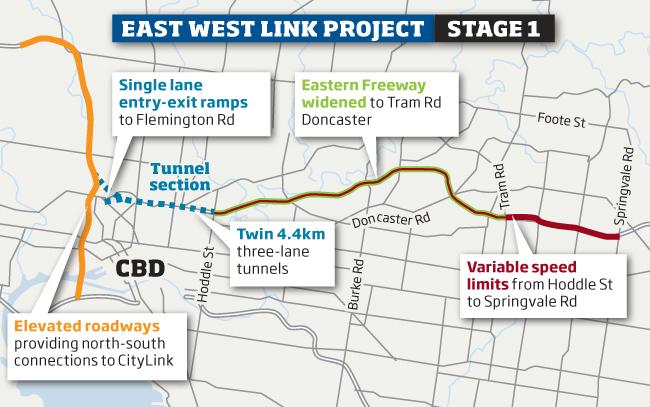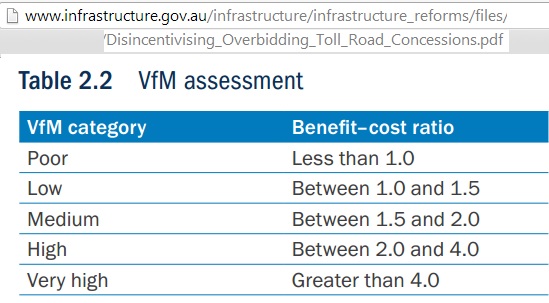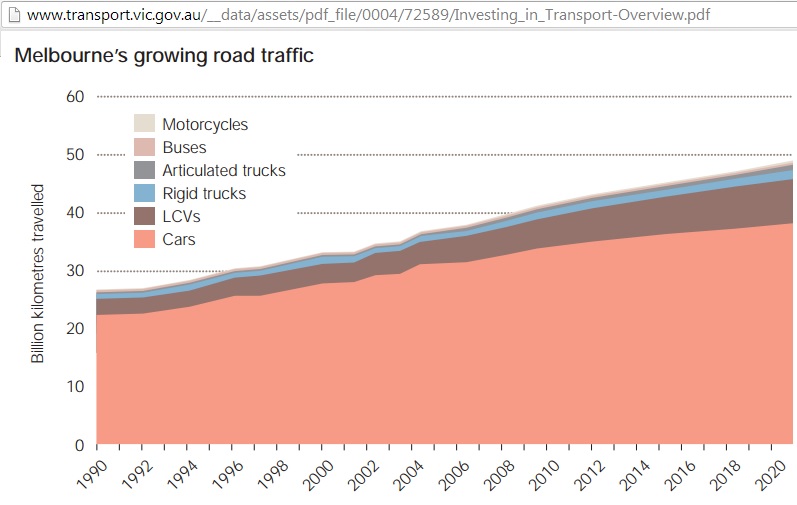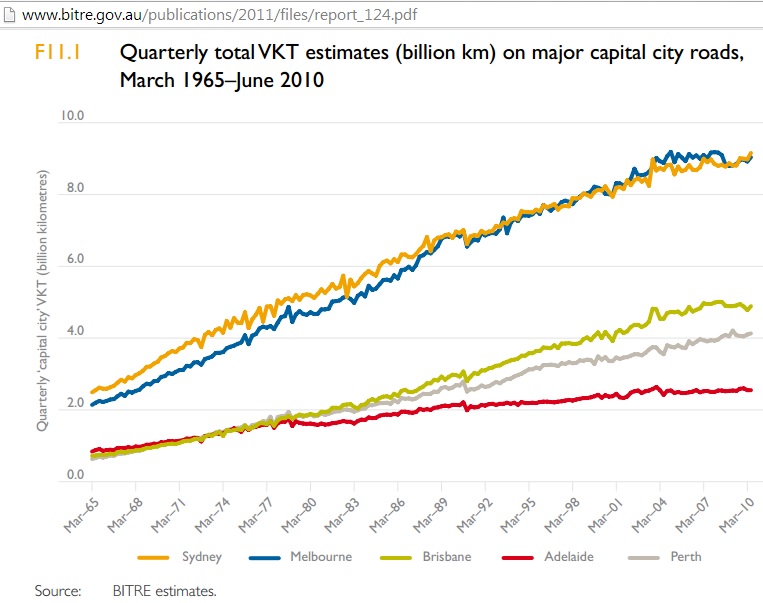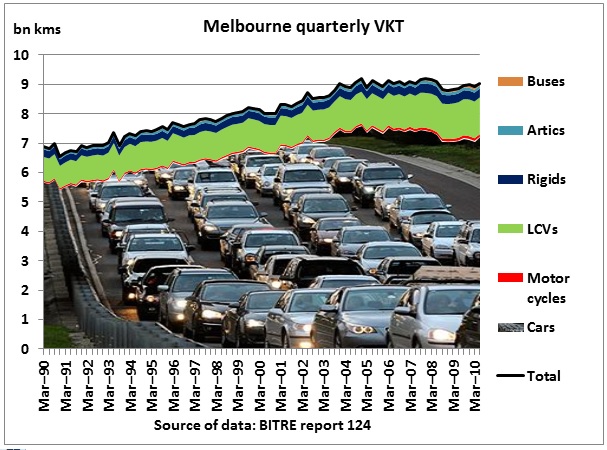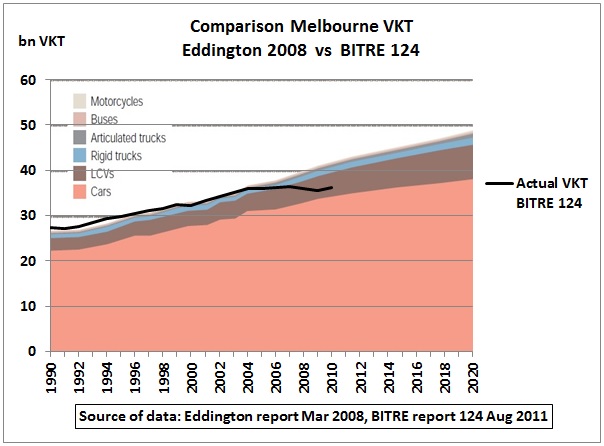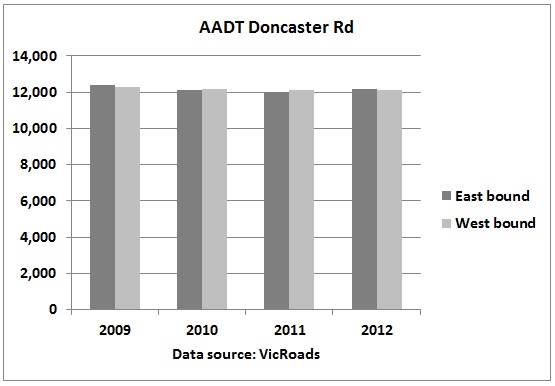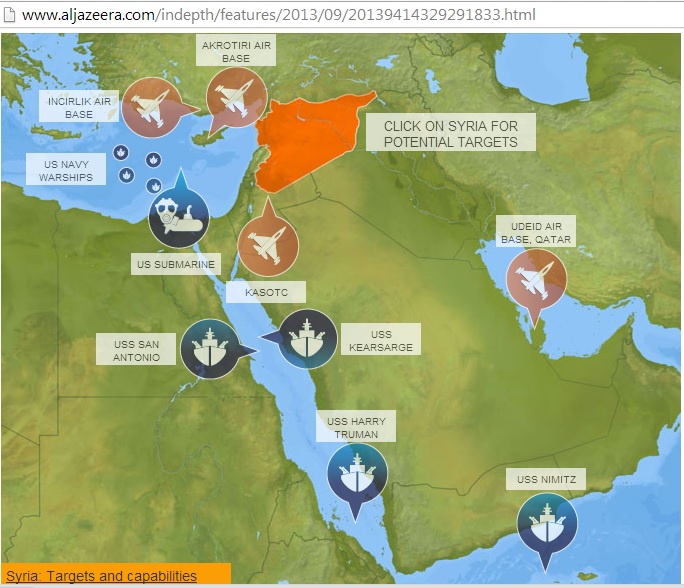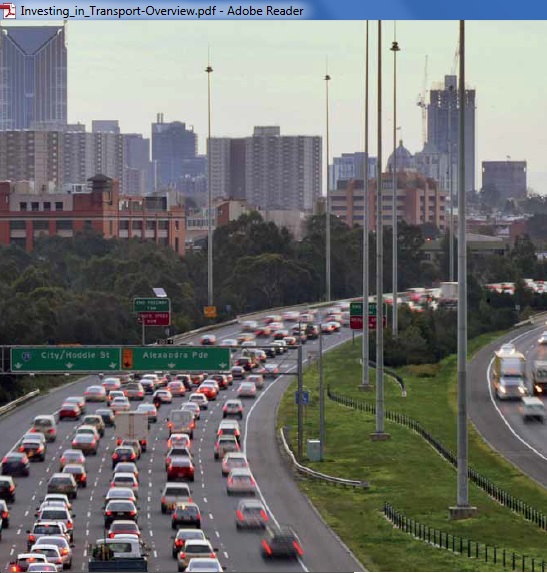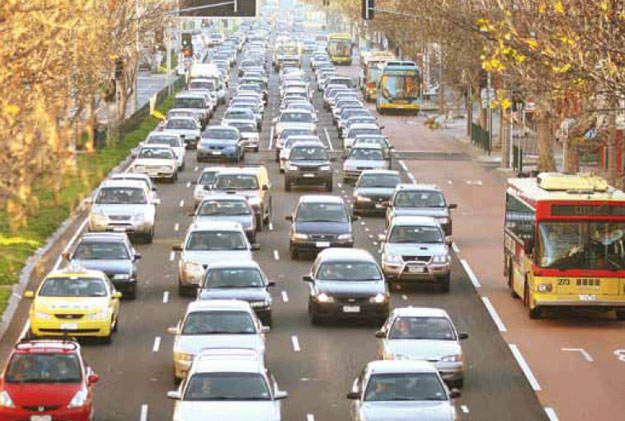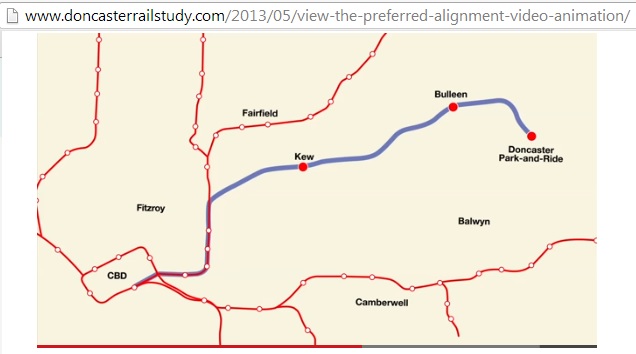According to the State government of Victoria’s “short form business case” a proposed road tunnel in Melbourne has only a benefit cost ratio of 1.4, a number which is classified as “low” by Infrastructure Australia. Moreover, no oil price risk analysis was done so events in the Middle East could bring the CBR below 1, meaning the project would cost more than the value of the benefits. What’s worse, the project has negative strategic value because it increases oil dependency.
What is proposed
This website is concerned with the obvious inability of governments to explain to the public that continuing high oil prices are the reason for the weakness in the economy, both globally and now also in Australia. Instead of preparing for the evolving oil crunch the public is offered a plethora of new road tunnel and toll-way proposals all of which are definitely not a solution to the problems we face.
The Liberal State government offer: THE EASTERN Freeway will be widened by one lane in each direction under the East West Link project.
NAOMI WOODLEY: Tony Abbott has already committed a future Coalition government to spending $1.5 billion on the project. The ALP doesn’t support it, and would prefer federal funds to be spent on urban rail instead.
http://www.abc.net.au/pm/content/2013/s3823797.htm
Mr Abbott said he had given a commitment that no infrastructure projects worth more than $100 million would be funded without a ”published cost-benefit analysis”.
Cost Benefit Analysis
Let’s check what is available on the cost-benefit analysis of the East West Link, prepared by the Victoria State government and titled “EAST WEST LINK STAGE ONE, Executive summary, Short form business case, information for Infrastructure Australia”:
The core result shows a benefit cost ratio of 1.4 including wider economic benefits as appropriate for a major project of this nature targeting economic growth.
The project is clearly of high economic worth, with a BCR of 1.4, having over $1.4 billion of net economic benefit and an internal rate of return of 9 per cent. (page 7)
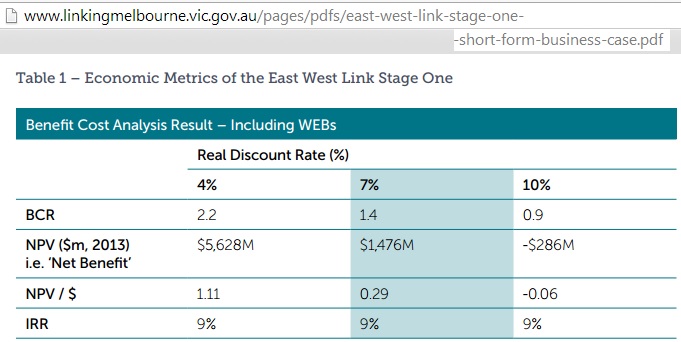
http://www.linkingmelbourne.vic.gov.au/pages/pdfs/east-west-link-stage-one–short-form-business-case.pdf
A BCR of 1.4 is not high as claimed, it is classified as “low” in a document of Infrastructure Australia titled “Disincentivising overbidding for toll-road concessions” (September 2012) quoting a value for money table from UK’s Treasury (2006).
One can calculate many different BCRs dependent on the assumptions which have been used. Apart from construction costs and assumed traffic, one major input parameter is the discount rate. We can see from the East West Link benefit cost table that BCRs and net present values vary substantially, meaning that these results are not robust and can be easily tweaked.
A good discussion on the role of discount rates can be found in this 2010 paper by the Productivity Commission
Valuing the Future: the social discount rate in cost-benefit analysis
http://pc.gov.au/__data/assets/pdf_file/0012/96699/cost-benefit-discount.pdf
Benefits in toll-way projects are usually monetised time savings of motorists. As traffic is assumed to grow, there will be more benefits in future. Lower discount rates favour these type of future benefits.
| NPV of $1 in: | ||
|
Discount rate |
10 years |
20 years |
|
4% |
$0.68 |
$0.46 |
|
5% |
$0.61 |
$0.38 |
|
6% |
$0.56 |
$0.31 |
|
7% |
$0.51 |
$0.26 |
|
8% |
$0.46 |
$0.21 |
|
9% |
$0.42 |
$0.18 |
This table shows that $1 benefit in 20 years has a NPV of 46 cents with a discount rate of 4% and a much lower NPV of 18 cents with a discount rate of 9%. We know that future traffic and therefore time saving benefits will be lower than assumed. Therefore, the higher BCRs under lower discount rates may not materialize.
No updated traffic projections
The latest documentation prepared in May 2013 “East West Link, Eastern section, project proposal” did not update previous traffic forecasts done in March 2008, BEFORE the GFC:
“The East West Link project was identified in Sir Rod Eddington’s East West Link Needs Assessment Report (EWLNA) in 2008……. There is a strong and growing demand for east-west trips north of the central business district, with around 210,000 vehicles trips per day currently taken along existing routes”
This is how the linear traffic growth (+4.2% pa) looked like in the EWLNA report of early 2008, until 2020:
Let’s have a look at VKT in Melbourne, from BITRE report 124 “Road vehicle kms travelled”
.
http://www.bitre.gov.au/publications/2011/files/report_124.pdf
We see that VKT in Melbourne (blue line) started to peak end 2004. Taking data from table T 8.3, available until mid 2010:
We superimpose annualised BITRE data on the Eddington graph:
We can clearly see that actual VKT for Melbourne did NOT grow as assumed.
Traffic peaked on Eastern Freeway
Closer to the project, we look at average daily traffic on the Eastern Freeway, using Vic Roads data:
AADT still grew at 1.3% pa (much less than the 4.2% of the Eddington report) until 2011 but declined in 2012 by -2.5%
Don’t believe it? Here is a partial screen shot from the Vic Roads website’s XLS file (sheet D-F, row 820) for Box Hill North, somewhere in the middle of the freeway, away from the end at Alexandra Pde where there are capacity limits.
Let’s compare AADT with ceiling capacities on different sections. As this article does not intend to do an exact engineering exercise we do simple calculations: number of lanes in one direction x 2,000 cars per lane x expansion factor 10. So it is assumed that the capacity of 3 lanes is 60,000 and of 5 lanes 100,000 cars per day.
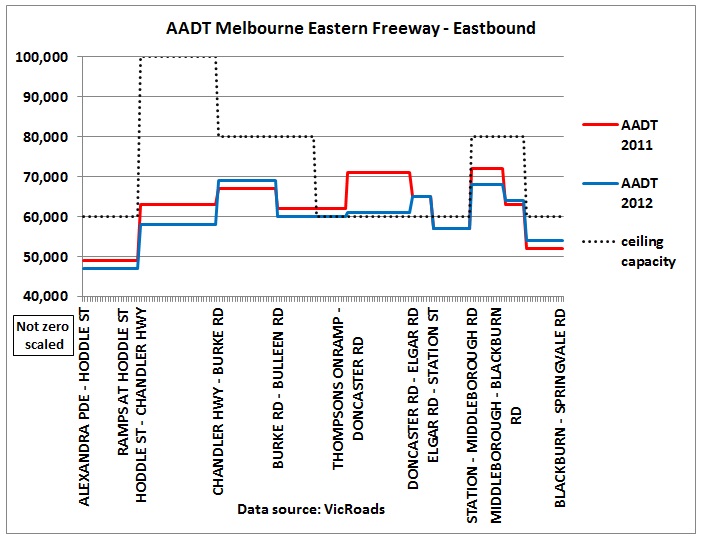
We see that in 7 sections (out of 10) traffic in 2012 was equal or less than in 2011. Where actual traffic (on 3 lanes) exceeded capacity, traffic in 2012 decreased most. The Westbound graph looks similar. So did motorists diverted to a rat race route? We check Doncaster Rd. which intersects the Eastern Freeway.
Congestion during peak hours while total traffic growth has stalled suggests that discretionary off-peak trips e.g. for shopping have decreased. This would be in line with a weak retail sector. Up to now, Australia was protected against high oil prices by a high AUD and the mining boom. But this period is coming to an end. Latest economic growth is at 2.6% pa, lower than 3% to 3.25% required for stable employment
http://www.cnbc.com/id/101006190
As unemployment goes up, peak traffic will soften. Will population growth change this? In the Asian Century?
160 million Chinese competitors against 12 million Australian motorists
Consider the growth of the Chinese car fleet and the resulting oil demand.
A recent Wood Mackenzie’s report found that from 2005-2020, China’s oil imports will rise from 2.5 million barrels per day (mb/d) to 9.2 mb/d:
20/8/2013
China’s growth in import demand can largely be attributed to its domestic oil demand growth, driven by gasoline demand due to the near-exponential increase in personal auto vehicles and diesel demand related to commercial trucking as China’s economy grows. Dr. Harold York, Principal Oils Markets Analyst explains, “Although lesser per capita by international benchmarks, by 2020 China will be second only to the US for the total fleet of personal auto vehicles in use. From 2005-2020, China will see the number of vehicles rise from 20 million to 160 million.”
http://www.woodmacresearch.com/cgi-bin/wmprod/portal/corp/corpPressDetail.jsp?oid=11495385
So population growth in Australia, largely driven by immigration, will sharpen the competition for oil in Asia, especially as Australian refineries are closing, and increase oil prices. That in turn will dampen economic activities.
In conclusion, proper traffic forecasts have to be done before tax payer money is spent in technical planning for new road tunnels.
Middle East disintegrates
Road tunnel proposals are debated while the Middle East, on which Australia is dependent at 37% in terms of oil supplies, continues to disintegrate in front of our TV eyes.
This is a good article describing what is going on:
Peak oil, climate change and pipeline geopolitics driving Syria conflict
Faced with dwindling profits from oil exports and a fiscal deficit, the government was forced to slash fuel subsidies in 2008 which at the time consumed 15% of GDP. The price of petrol tripled overnight, fuelling pressure on food prices.
The crunch came in the context of an intensifying and increasingly regular drought cycle linked to climate change Between 2002 and 2008, the country’s total water resources dropped by half through both overuse and waste.
Once self-sufficient in wheat, Syria has become increasingly dependent on increasingly costly grain imports which rose by 1m tonnes in 2011-12, then rose again by nearly 30% to about 4m in 2012-13. The drought ravaged Syria’s farmlands, led to several crop failures, and drove hundreds of thousands of people from predominantly Sunni rural areas into coastal cities traditionally dominated by the Alawite minority.
The food price hikes triggered the protests that evolved into armed rebellion, in response to Assad’s indiscriminate violence against demonstrators. The rural town of Daraa hit by five prior years of drought and water scarcity with little relief from the government, was a focal point for the 2011 protests.
The origins of Syria’s ‘war by proxy’ are therefore unmistakeable – the result of converging climate, oil and debt crises within a politically repressive state, the conflict’s future continues to be at the mercy of rival foreign geopolitical interests in dominating the energy corridors of the Middle East and North Africa.
http://www.theguardian.com/environment/earth-insight/2013/may/13/1
http://www.aljazeera.com/indepth/features/2013/09/20139414329291833.html
So where is the East-West Links’s risk analysis for the next oil war in the Middle East? It seems governments live in La La land.
Bad Town Planning
Mono-directional traffic flows to/from a high density CBD demonstrate the total failure of governments and investors to decentralize commercial development into subcentres closer to a sheer endless suburbia.
Eddington not in favour of rail
The Eddington report contains recommendation 6 to upgrade bus services of the Doncaster Area Rapid Transit (DART) project, but is not in favour of rail:
Building a heavy rail link to Doncaster would not significantly relieve congestion at the city end of the Eastern Freeway.
The Study Team’s view is that the evidence does not support investment of between $600 million and $2 billion in a heavy or light rail link to the Doncaster area being given priority. When the relatively small number of additional people switching from private vehicles is taken into account – and when compared with other public transport priorities – these investments do not represent value-for-money for Melbourne.
Obviously, Eddington has no idea how peak oil will evolve.
In the meantime:
Hoddle St inbound bus lane in AM peak – however there’s no bus lane on the other (outbound) side
http://blogs.crikey.com.au/theurbanist/2012/07/08/whats-so-hard-about-a-bus-lane/
Rail solution
http://www.doncasterrailstudy.com/
Animation of alignment
http://www.youtube.com/watch?v=J-rexASpUqM
Presentation by team leader Tim Gosbell of phase 1 recommendations
http://www.youtube.com/watch?v=LROxxYDrgmI
Conclusion
No doubt the few years US shale oil has given us to get away from oil will be wasted. The love affair with cars and the business of toll-roads will go on. The endless study carousel will continue to turn until one day there is a physical oil shock which will wake up the public to some inconvenient facts.
Addendum
Bizarre. Shrinking petrol price rises needed for a BCR=1.4
2/10/2013
The financial case for the east-west link hinges on a prediction that toll road use will jump over the next 30 years because of rising wealth and shrinking petrol and CBD parking price rises.
A cabinet-in-confidence document, obtained by Fairfax Media, for the first time details key assumptions used to justify the $6 billion to $8 billion project, which the state government claims will produce a return of $1.40 for every $1 invested.
A discussion paper produced by VicRoads, the Linking Melbourne Authority, the Transport Department and Public Transport Victoria, reveals the government was able to boost its predictions for the road by as much as 15 per cent using a controversial assumption that time will be more valuable to future motorists because of rising wealth.
The report, used to prepare the highly secretive business case for the road, says the methodology ”has not been used in any of [the Transport Department’s] other public transport projects or program modelling to date”.
Despite this, it says there is ”evidence to suggest that as the community’s wealth increases more people are prepared to pay tolls as they value their time more highly”. As a result, the business case assumes car drivers will be 1.4 per cent more willing every year to use toll roads over non-toll roads, while drivers of commercial vehicles will be 1.8 per cent more willing to pay tolls.
The document reveals that this assumption alone meant predicted traffic volumes were 15 per cent higher by 2031 than they otherwise would have been had the methodology not been used. ”This is … inconsistent with initial modelling for the Eastern Freeway undertaken for the Doncaster Rail Feasibility Study,” it says.
While the cost of inner-city parking is currently rising by about 4 per cent a year in real terms (above inflation), the business case assumes the annual rate of increase will fall by more than half to 1.6 per cent by 2041.
It also predicts growth in the cost of operating a car – mostly petrol prices, but also maintenance, insurance and registration – will slow from an annual rate of 2 per cent to 0.5 per cent by 2041.
A source said there had been internal concern that the government had been prepared to use ”garbage” assumptions to make the project appear to stack up, accusing it of manipulating modelling to produce a favourable result.
But another source familiar with the modelling work said the assumptions were standard.
While previous projects have relied on the ”in-house” Victorian Integrated Transport Model to assess major projects, the government outsourced the east-west link process to Brisbane-based company Veitch Lister, making scrutiny difficult.
Opposition planning spokesman Brian Tee accused the government of ”playing the public for suckers” by deliberately using spurious assumptions to justify the link.
”It is a fraud on the Victorian people, and the real price is the schools, hospitals and roads which could have been built if the government wasn’t so hellbent on delivering this dog of a project,” he said.
A government spokeswoman said the Comprehensive Impact Statement, due to be released in November, would include further, detailed traffic modelling information.
A government source described the earlier document, from mid last year, as out of date, saying it should not be relied upon.
The government has so far refused to release the full business case for the project, releasing instead a ”short form” version asserting the project will generate a return of $1.40 for every $1 investment. Earlier studies have found the link, connecting the Eastern Freeway to the Tullamarine Freeway, would be unlikely to be viable, generating just 50¢ for every $1 invested.
http://www.theage.com.au/victoria/secret-case-for-link-revealed-20131001-2ur5r.html
